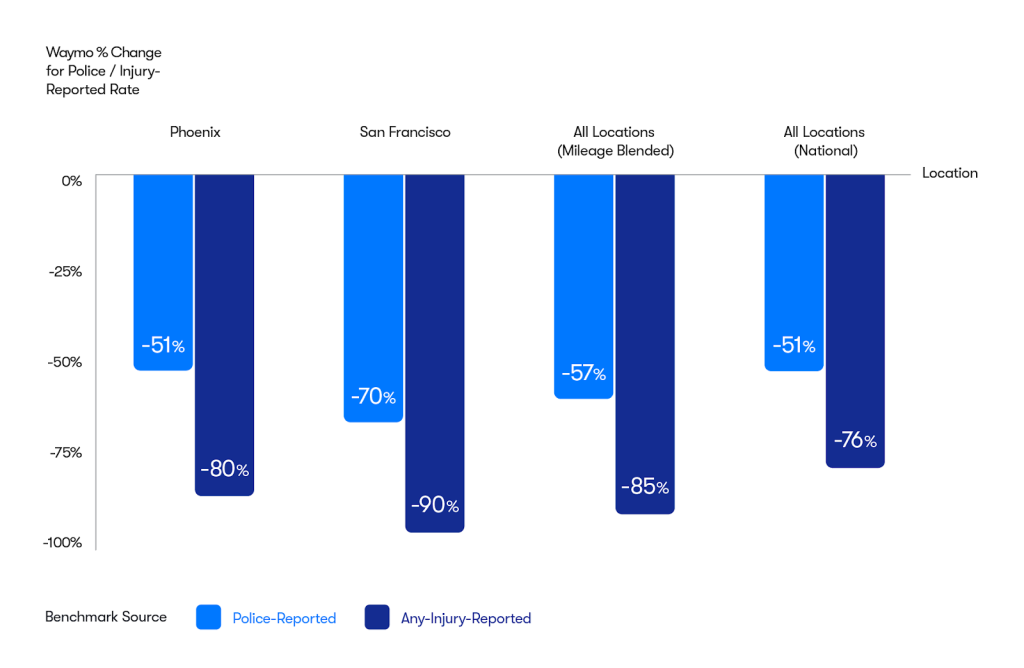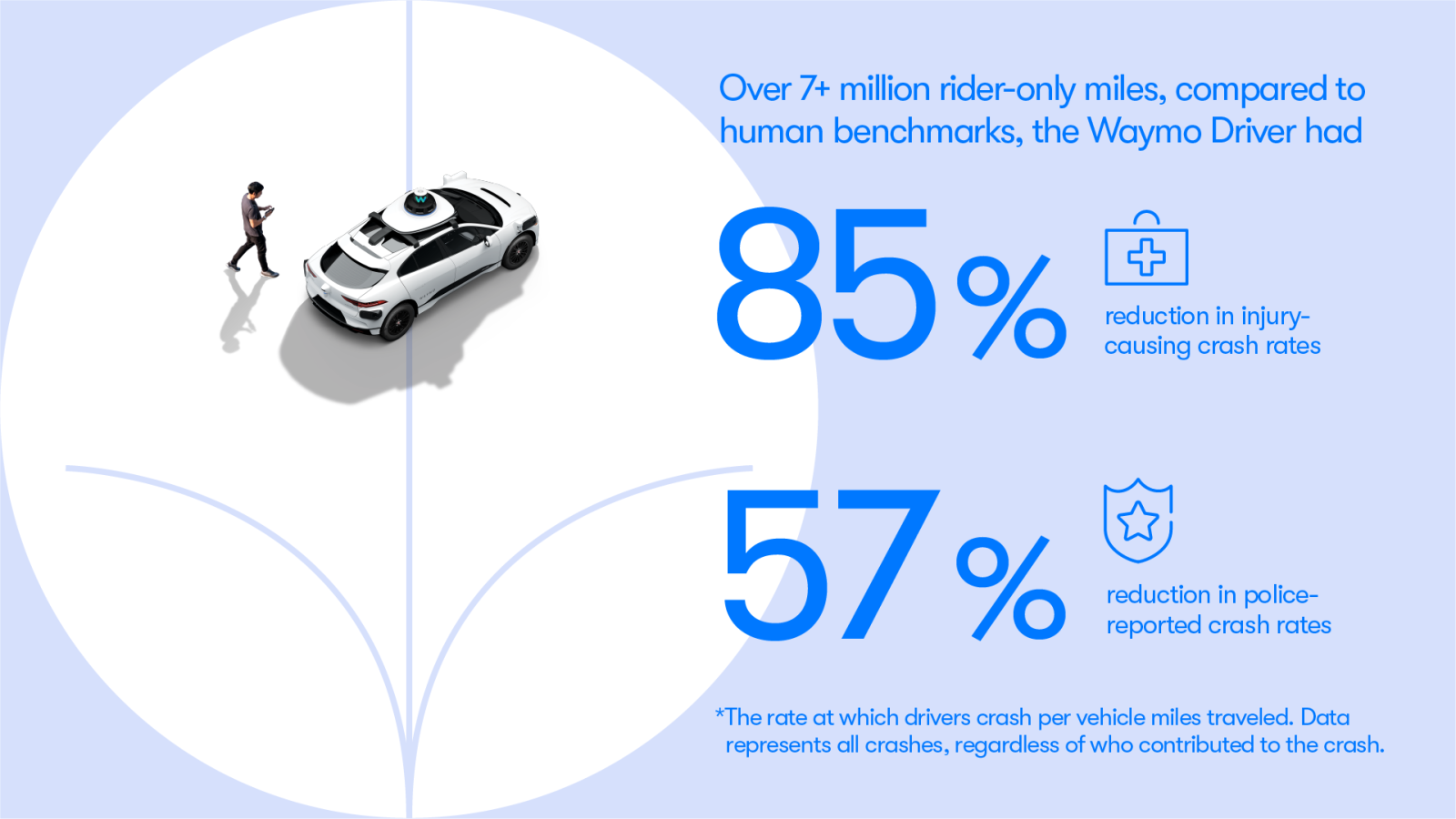Waymo says its self-driving cars are safer than human drivers by up to 10x
Waymo has released a report saying that its Waymo Driver self-driving vehicles outperform human drivers significantly, leading to much fewer crashes and injuries when compared to benchmark human drivers.
Waymo’s data claims a 57% reduction in crashes that were reported to the police and an 85% reduction in crashes that caused any bodily injury. The data represents 7.14 million rider-only miles, and is compared to a baseline of how commonly human drivers get into crashes in the same area.
Currently, Waymo covers parts of San Francisco, Phoenix and Los Angeles. Crash rates varied by location, with San Francisco having the highest rate of human-driven crashes at 5.55 per million miles.
Waymo put additional effort into figuring out exactly what the benchmark crash rates should be in each area, releasing a study about these calculations specifically.
One correction that Waymo included was crash underreporting by human drivers, where smaller crashes that don’t include injury often go unreported to the police. Waymo said that “in contrast, autonomous vehicle companies report even the most minor crashes in order to demonstrate the trustworthiness of autonomous driving on public roads” (perhaps a dig at AV competitor Cruise, who were recently caught hiding information from California regulators).
Also, road type is important, as Waymo only operates on surface streets and not highways. Highways tend to have fewer accidents than surface streets because they are less complex.
When breaking down the comparison by location, Waymo’s data shows that it’s up to 10x less likely to cause injury than human drivers (in San Francisco), but with large reductions in all cases.

Los Angeles is not included in this breakdown due to the small number of miles that Waymo has driven in LA – it’s currently only there in a preliminary capacity, and you can read our experience riding it in Venice here.
Waymo released this report just a day after another report from LendingTree which claims that Tesla drivers have the highest accident rate, in seeming contrast to Tesla’s own released data claiming that Autopilot is much safer than human drivers (though, if Autopilot-driven miles are a small enough proportion of total miles, these statements can both be true at the same time – or if Tesla drivers are phenomenally more crash-prone, which seems unlikely).
Tesla used to release its Autopilot safety data on a quarterly basis, but stopped about a year ago. The data and methodology of Tesla’s releases were much less robust than the study that Waymo has released, but both should be taken with a grain of salt since both were released by the companies themselves, who have an obvious incentive to present data in the best light possible for themselves.
Waymo previously released a report claiming 100% reduction in bodily injury, but that report only covered data until August 1, 2023. Waymo has since reported three accidents including bodily injury to the NHTSA – one each in August, September and November of this year. The previous report was done in conjunction with Swiss Re, a large insurance company.
You can click on through to read Waymo’s full study or its blog about the study.
FTC: We use income earning auto affiliate links. More.

Waymo has released a report saying that its Waymo Driver self-driving vehicles outperform human drivers significantly, leading to much fewer crashes and injuries when compared to benchmark human drivers.
Waymo’s data claims a 57% reduction in crashes that were reported to the police and an 85% reduction in crashes that caused any bodily injury. The data represents 7.14 million rider-only miles, and is compared to a baseline of how commonly human drivers get into crashes in the same area.
Currently, Waymo covers parts of San Francisco, Phoenix and Los Angeles. Crash rates varied by location, with San Francisco having the highest rate of human-driven crashes at 5.55 per million miles.
Waymo put additional effort into figuring out exactly what the benchmark crash rates should be in each area, releasing a study about these calculations specifically.
One correction that Waymo included was crash underreporting by human drivers, where smaller crashes that don’t include injury often go unreported to the police. Waymo said that “in contrast, autonomous vehicle companies report even the most minor crashes in order to demonstrate the trustworthiness of autonomous driving on public roads” (perhaps a dig at AV competitor Cruise, who were recently caught hiding information from California regulators).
Also, road type is important, as Waymo only operates on surface streets and not highways. Highways tend to have fewer accidents than surface streets because they are less complex.
When breaking down the comparison by location, Waymo’s data shows that it’s up to 10x less likely to cause injury than human drivers (in San Francisco), but with large reductions in all cases.

Los Angeles is not included in this breakdown due to the small number of miles that Waymo has driven in LA – it’s currently only there in a preliminary capacity, and you can read our experience riding it in Venice here.
Waymo released this report just a day after another report from LendingTree which claims that Tesla drivers have the highest accident rate, in seeming contrast to Tesla’s own released data claiming that Autopilot is much safer than human drivers (though, if Autopilot-driven miles are a small enough proportion of total miles, these statements can both be true at the same time – or if Tesla drivers are phenomenally more crash-prone, which seems unlikely).
Tesla used to release its Autopilot safety data on a quarterly basis, but stopped about a year ago. The data and methodology of Tesla’s releases were much less robust than the study that Waymo has released, but both should be taken with a grain of salt since both were released by the companies themselves, who have an obvious incentive to present data in the best light possible for themselves.
Waymo previously released a report claiming 100% reduction in bodily injury, but that report only covered data until August 1, 2023. Waymo has since reported three accidents including bodily injury to the NHTSA – one each in August, September and November of this year. The previous report was done in conjunction with Swiss Re, a large insurance company.
You can click on through to read Waymo’s full study or its blog about the study.
FTC: We use income earning auto affiliate links. More.
